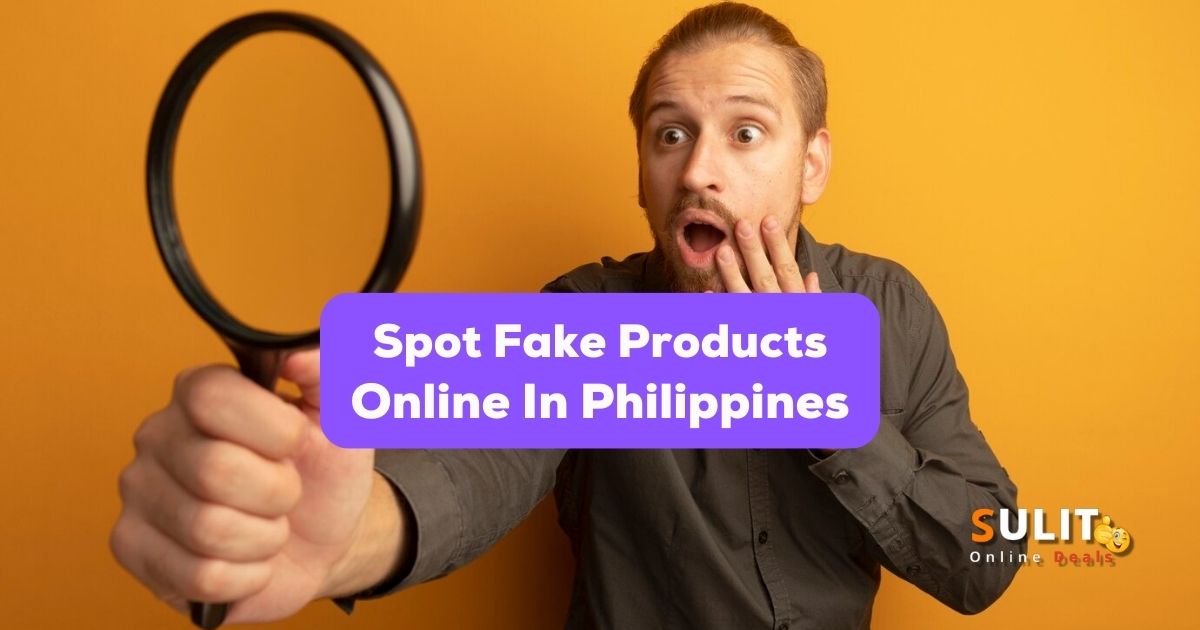The rise of e-commerce has led to an influx of counterfeit and knockoff products being peddled online. As an avid online shopper in the Philippines for over 13 years, I’ve learned how to spot fake products online in Philippines to avoid getting scammed and ending up with fake merchandise.
In this comprehensive guide, I’ll share all my very own online shopping tips and tricks in Philippines for easily identifying and avoiding counterfeits when shopping on Philippine e-commerce sites.
Table Of Contents
The Thrill And Risks Of Online Shopping In The Philippines
It’s no secret that Filipinos love to shop online. Marketplaces like Lazada and Shopee have transformed how we purchase products, bringing convenience and variety that physical stores can’t match.
Any item you can think of is likely available from the comfort of your gadget 24/7. With discounted deals and efficient delivery, it’s easy to get hooked on online shopping.
Based on my research, retail e-commerce sales in the Philippines are projected to grow from $12 billion in 2021 to over $40 billion by 2025. However, the massive growth of e-commerce here has a dark side. As online shopping scams in Philippines explode, so do shady practices like peddling knockoffs and fake products.
Counterfeit items may be more prevalent than you think. A recent report found that 4 out of 10 Filipinos have likely purchased counterfeit goods online. From potentially dangerous beauty items to costly yet fake electronics, falling victim to these fakes can be both a health hazard and a financial nightmare.
As an experienced online shopper, I’ve had my fair share of encounters with counterfeit products. There was that trendy phone case that fell apart after a week, the sweater that wasn’t even made of real wool, and the exfoliating scrub filled with who knows what mystery ingredients. These incidents taught me to be vigilant to avoid repeats in the future.
So, how do savvy Filipino shoppers like us avoid getting duped? Let me share the insider techniques to spot fake products online in Philippines that I’ve learned over the years for spotting counterfeits easily.
How To Spot Fake Products Online In Philippines?
Spotting fakes, counterfeits, and knockoffs takes some knowledge and effort. After being tricked a few times, I realized I needed to learn how to identify fakes quickly. Here are the techniques I use for different product categories:
1. Examine Photos Carefully
The first step in identifying online fake products is a careful visual inspection of the product photos. Over the years, I’ve gotten good at finding the tiny details that give away something is amiss. Here’s what to look for:
- Blurry, grainy images that mask details – Counterfeiters try to hide shoddy quality with fuzzy pics. Red flag!
- Visible flaws, cheaper materials, shoddy stitching – Zoom in to try and spot crappy materials, uneven stitches, gaps in bonding, etc.
- Wrong colors, textures, or design details – Know the real product specs so mismatches stand out. Fakes tend to get colors and textures wrong.
- Differences compared to authentic photos of the same product – Study official product shots then compare to seller pics side-by-side. Different = dubious.
Evaluate both the featured image and any additional photos of the product from other angles. Zoom in and inspect closely for anything that seems off. Look for blurriness, weird edges, differences in design, etc.
2. Read Descriptions Thoroughly
Don’t just browse the photos – read the full product description too. I’ve caught obvious fakes from the description details many times. Watch for:
- Spelling mistakes and grammatical errors – Sloppy language often signals an amateur counterfeiter.
- Missing details about materials, sizes, etc – Genuine sellers will list complete specification. Fakes tend to have vague or missing information.
- Generic praise like “high quality” without specifics – Real sellers give details on materials, manufacturing, etc. Fakes just claim “best quality!”
- Sketchy claims like “authentic” and “original” – An honest seller doesn’t need to insist it’s real. Methinks they doth protest too much!
The lack of detailed specifications is a clear giveaway that the seller doesn’t actually know the specific product details. So, watch out!

3. Check For Unrealistically Low Prices
If a deal seems too good to be true, it usually is. Knockoff products are often listed at prices drastically lower than the real deal. Be suspicious of:
- Prices 50% or more below MSRP for luxury or specialty items – A ₱98,000 iPhone 15 Pro Max selling for ₱23,000? Must be fake.
- Discounted prices way below the same item at other sellers – If it’s 50% cheaper than the rest, something’s wrong. Use price comparison sites or visit the product’s official page.
- Sudden “flash sale” discounts on expensive products – Dishonest sellers will create a false sense of urgency and exclusivity. Don’t fall for it!
I’ve been burned a few times, getting excited over unbelievable discounts only to receive a counterfeit item. Use price comparison sites to check if the price is unbelievably low for what’s being sold. Discounted doesn’t always equal fake, but unbelievable deals are clear red flags for counterfeits.
4. Verify The Seller’s Reputation
Buying directly from well-known retailers like Zalora or Adidas is ideal for avoiding fakes. But when purchasing from third-party sellers like those newly created profiles on Facebook and Instagram, investigate their reputation thoroughly:
- Reviews from other buyers – Read recent reviews. Complaints about fakes are a huge red flag. But beware of fake reviews too!
- Ratings – Consistent negative ratings should raise alarms. But unscrupulous sellers can fake ratings too.
- Location – Overseas sellers tend to be more risky compared to local ones.
- Listing history – How long have they been selling on the platform? Newbies are higher risk.
I’ve been fooled by seemingly reputable sellers who ended up sending a fake pair of shoes. Now, I dig deeper beyond just the ratings and reviews. Reputable sellers value their hard-earned ratings. Be very wary of sellers with zero or overwhelmingly negative ratings.
5. Read Product Reviews Carefully
Another best way to spot fake products online in Philippines is to check for legitimate reviews. Well-written reviews from other buyers detailing personal experiences can help identify fakes. Here’s what to look for:
- Reviews mentioning receiving fakes or different items – Obviously a red flag!
- Complaints about poor quality or not matching the description – Makes you wonder…
- Minimal reviews or reviews that seem copied and pasted – Genuine sellers will have more detailed reviews.
Look beyond the overall rating and read through the recent reviews for any red flags. Legitimate products will have predominantly favorable reviews. Lots of complaints should make you pause before buying.
6. Verify Payment And Shipping Details
By default, use the payment methods available on the marketplace platform itself rather than direct bank transfers. Avoid sellers who:
- Insist on direct bank payments outside the platform’s secure payment system – Scammers operate outside official payment channels.
- Use multiple accounts – Shady sellers switch accounts to avoid negative reviews and ratings.
- Offer meetups or shipping from unknown locations – Meetups are almost always a scam. You’re safer with COD or cash on delivery, but make sure to open the package first and take a video of receiving the item from the rider until you finish testing the product.
Paying through the platform itself offers buyer protection. Scrutinize any deviation from standard payment and shipping practices. I stick to platform payments like LazPayLater and ShopeePay only now after some tough lessons!

Advanced Techniques For Authentication
For high-value or specialty items, go beyond the basics with these expert authentication techniques. Here are more advanced procedures for spotting fake products when shopping online in Philippines:
1. Get Familiar With The Brand
For brands you buy often, familiarize yourself with their trademarks, materials used, manufacturing details, country of origin, and other authenticity markers. Follow official brand social media accounts and official websites that give close-up views of new products.
Knowing the brand intimately makes spotting discrepancies much easier. For example, I love shopping on Zara online. By following their Instagram and browsing the website regularly, I’ve become very familiar with their clothing materials, stitching, tags, and packaging. This makes it easier to spot potential knockoffs other sellers list.
2. Request More Photos
If you notice something suspicious in a seller’s photos, ask them for additional photos of logos, materials, serial numbers, etc. to clear your doubts. Responsible sellers will gladly provide detailed photos from multiple angles. Scammers will likely block you on their Messenger, disappear, or make excuses.
I’ll often message sellers saying something like, “Hi, can I please get more photos of the logo stitching and tags? Want to confirm authenticity before purchasing.” A real seller will gladly comply. A fake one will evade.
3. Inspect Packaging Upon Delivery
When you receive the product, inspect the packaging and contents closely and compare them to the real product and official photos. Authentication cards, manuals, warranty cards, and unique packaging can help identify genuine products.
I open packages carefully and take a video or photograph of the contents right away in case I need to dispute it later. Things I check are materials, stitching, QR codes, branding, tags, accessories included, scent (for beauty items), and quality of packaging. Any deviation from official photos or unboxings is a giveaway of a fake.
4. Submit Questionable Items For Authentication
For high-end designer and luxury goods, a professional authentication service may be worthwhile for peace of mind. They can examine items firsthand and issue certificates of authenticity. Well-known companies include Entrupy, RealAuthentication, and AuthenticateFirst.
I’ve used authentication services a couple times for expensive bags I wasn’t 100% sure about. While it costs a few thousand pesos, it’s worth it for expensive designer and limited edition products. The certificate gives me confidence I can resell the item later.
5. Test Expensive Electronics Promptly
Electronics like cellphones and laptops are a prime target for scammers. When you receive a big ticket electronic item, thoroughly test it and use it immediately. Run diagnostic tests if possible. Confirm hardware performance and specs match official product info.
I was ecstatic to get a brand new Xiaomi Redmi phone for 50% off only to find out it was just a convincingly repackaged fake that couldn’t even run most apps. Now I thoroughly benchmark test electronics directly upon delivery.
By mastering visual inspection, price analysis, seller reputation checks, and other verification skills, you’ll get the best online deals in Philippines and avoid wasting money on counterfeit goods when shopping online. It just takes practice training your eye to spot potential fakes.
Why Knockoffs And Fake Online Products Are Problematic
Now that you know the most useful authentication techniques, let’s briefly discuss why counterfeits mean trouble. Unwittingly purchasing fake goods online in the Philippines can lead to:
- Safety risks – Counterfeit beauty, food, and medical products can contain dangerous substances and cause adverse reactions. Fakes won’t have undergone proper testing or quality control and evaluation for safety. I once bought an underarm whitening product online that caused a bad rash – who knows what toxicity was in that thing!
- No guarantees – Genuine brands back their products with generous warranties and guarantees. Fakes offer no such protection against defects. Good luck getting a refund or replacement if that fake gadget stops working shortly after receiving it!
- No recourse – It’s tough getting accountability or compensation from unscrupulous counterfeiters operating illegally. They don’t have customer service hotlines or respond to emails from unhappy buyers of their fake products.
- Financial loss – Paying good money for expensive branded items that turn out fake means losing your hard-earned cash. I’ve lost a couple thousand pesos over the years from convincing fakes tricking me.
- Supporting illicit activity – The counterfeit industry robs governments of taxes and revenues while exploiting child labor in some cases. It’s an unethical business all around.
By staying vigilant against fakes, we can shop online in Philippines safely while supporting legitimate businesses. But is online shopping safe in Philippines? Not 100%, so always be careful and follow the tips I have shared.

Staying Safe When Shopping Online In Philippines
Here are my final tips for staying vigilant and shopping safely:
- Stick to trusted platforms like Lazada and Shopee.
- Bookmark seller profiles you’ve bought from previously. Develop a network of trusted sellers.
- Avoid direct payments and meetups for higher-priced goods. Too risky!
- Review return policies in case you inadvertently receive a fake.
- Report suspicious sellers or listings to platform administrators to get them shut down. I’ve done this a few times!
- If the deal seems too good to be true, proceed with extreme caution!
- Trust your gut feeling. If something seems sketchy, it probably is.
While the convenience of e-commerce makes cheap online shopping in Philippines addictive, always keep your guard up. Follow this guide, and you can continue enjoying online deals without the headaches of counterfeit products! Stay vigilant and happy authentic shopping my friends.
Let me know if you have any other tips and tricks on how to spot fake products online in Philippines because even after a decade of online shopping, I’m still learning new ways to notice counterfeits. It’s a constantly evolving battle as the scammers get more sophisticated too. Share your stories and advice in the comments! I hope this guide helps more Filipino shoppers make informed purchases and avoid being duped. Ingat kayo!
FAQs About Fake Products Online In Philippines
How do you check if a product is authentic when shopping online in the Philippines?
Look for clear, detailed photos and product descriptions. Check the seller’s ratings and reviews for consistency and authenticity signs. Use the brand’s official website or customer service to verify serial numbers or unique identifiers.
How do you know if a brand is real on Filipino online marketplaces?
Research the brand’s official online presence and compare it with the seller’s listing. Genuine brands often have official retailers or verified badges on marketplaces. Be wary of prices significantly lower than the usual retail price.
How do I scan an original product to verify its authenticity?
Some brands offer apps or websites where you can enter serial numbers or scan QR codes to verify products. Look for these features in the product packaging or contact the brand’s customer service for instructions on how to authenticate your purchase.



